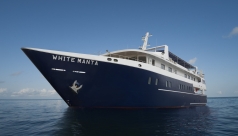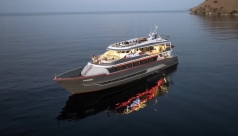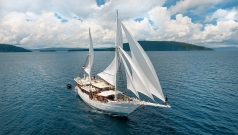Dive Destinations
Liveaboards
Resorts / Day Trips
Scuba Training
Recent studies have shown that the marine diversity in Indonesia's West Papua Province is considerably greater than all other areas sampled in the Coral Triangle (made up of Indonesia, the Philippines and Papua New Guinea), which simply means it is the best of the best. Among the best experiences you can have whilst Raja Ampat liveaboard diving are encounters with indigenous wobbegongs, the incredible topside beauty of Waigeo, the mushroom islands and lagoons of Misool, and the sheer joy of simply drifting over some of the most pristine and colourful coral scenes on Earth.
Raja Ampat liveaboard cruises include dives at Fabiacet; a site that proves that you can believe the hype, with more fish life than you thought possible. Here are great hammerheads, green turtles, schools of fusiliers and pale-lipped surgeonfish, red-toothed triggerfish and bannerfish, to name but a few.
Farondi Island offers tunnels, caverns and walls festooned with fascinating marine life. There is plenty of action in the blue, but the highlights are to be found in and around the reef, such as ornate ghost pipefish and pygmy seahorses (up to 40 on 1 fan!). Manta Ridge at Mansuar Island is one of many dives sites where manta rays can be seen, but it stands alone in terms of numbers. Up to 30 different mantas can be seen here making it surely one of the best manta dives in the world. [More details on these dive sites: Raja Ampat].
The Raja Ampat liveaboard routes used by diving charters in the Raja Ampat National Park cover a huge area of sea in this eastern section of Indonesia. They take in both the northern and southern sections of the park. Trips tend to be between 8-14 nights' duration.
However, there are some 6 to 9 night trips that focus on either the north, south or central regions of Raja Ampat, in and out of Sorong. Southern tours often focus on dive areas around the island of Misool, such as Fabiacet, Daram, Farondi, Wayilbatan and Boo Island. The central region includes sites like Cape Kri, Mansuar, Gam, Jef Fam, South Penemu, Mioskon and Waigeo. The less-travelled northern route visits Wayag, Kawe, Aljui Bay and Uranie.
Cruises of such length and the remoteness of the location means that the normal clientele on these tours are experienced scuba divers who have visited in many other countries before treating themselves to this pinnacle of liveaboard destinations.
Raja Ampat is also a frequently included in the routes of liveaboard transit trips to other Indonesian diving hot spots such as Cenderawasih Bay, Triton Bay, the Banda Sea & Ambon, Halmahera, Lembeh Strait, The Forgotten Islands and Alor. See our dedicated Transit Trips section for more details.
> [More details: Raja Ampat Trips]
Customer rating: Excellent!

Customer rating: Excellent!

Customer rating: Excellent!

Customer rating: Excellent!

Customer rating: Excellent!

Customer rating: Excellent!

Customer rating: Excellent!

Customer rating: Excellent!

Customer rating: Excellent!

Customer rating: Excellent!

Customer rating: Excellent!

Customer rating: Excellent!

Customer rating: Very good!

Customer rating: Very good!

Customer rating: Very good!

Customer rating: Very good!

Customer rating: Very good!

Customer rating: Very good!

Customer rating: Very good!

Customer rating: Very good!

Customer rating: Very good!

Customer rating: Good

Customer rating: Good

Customer rating: Good

Customer rating: Good

Customer rating: Good

Customer rating: Good

Customer rating: Good

Customer rating: Average

Customer rating: Be first to rate!

Customer rating: Be first to rate!

Customer rating: Be first to rate!

Customer rating: Be first to rate!

Customer rating: Be first to rate!

Customer rating: Be first to rate!

Customer rating: Be first to rate!

Customer rating: Be first to rate!

Customer rating: Be first to rate!

Customer rating: Be first to rate!
The West Papua Province has some liveaboard boats operating all year but many Raja Ampat diving operators restrict their charters to October-April as there is less chance of rain and choppy seas then. Outside of these times, the Indonesian liveaboards often move onto Komodo and Banda, or over to the north coast of Papua into Cenderawasih Bay for the whale shark season.
Water temperatures in Raja Ampat are warm all year round, ranging from 30°C in November to April, to 27°C from May to October. October to April is peak manta ray season as they come in great numbers to feed on the plankton blooms.
Raja Ampat liveaboard cruises normally depart from Sorong or Waisai in West Papua. You can fly to Sorong direct from Bali, Jakarta, or via Ujung Pandang or Manado. If your trip departs from Waisai, you must take the twice-daily ferry to Waisai from the Sorong public harbour. It takes approx. 2 or 3 hours. Cruises that include Cenderawasih Bay may use the ports of Manokwari in West Papua, Nabire or Biak in Papua Province. From Jakarta you can fly to Manokwari via Ujung Pandang. You can fly direct to Biak from Ujung Pandang and Jayapura. You can fly to Nabire from Jakarta and Surabaya via Ambon. If your Raja Ampat cruise includes Triton Bay it may use the port of Kaimana in the south of West Papua, which you can fly to from Ujung Pandang (via Ambon), or from Sorong.
Find departure ports in each boat's 'Departure Schedule & Prices' section. We'll email full details after booking, and transfers from airports/hotels are typically included. Most liveaboard guests fly into Indonesia to Jakarta (CGK), Manado (MDC) or Denpasar (DPS). Read more information on: how to get to Indonesia.
Secure dive insurance (including trip cancellation) through our insurance partners:
Super speedy service from Beef as always. I have booked several dive packages with Beef and have always been satisfied with him. Your website is very informative and the best thing about your service is the speedy, prompt replies.
